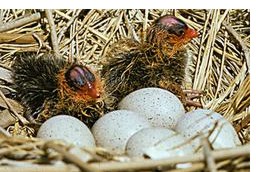Defences against Brood Parasitism
Birds parasitized by interspecific brood parasites often adopt defences based on egg recognition, but such behaviors are puzzlingly rare in species parasitized by members of the same species. Conspecific egg recognition is frequent, accurate and used in three defences that reduce the high costs of conspecific brood parasitism in American coots.
 During a study of American coots, chick starvation was ubiquitous: 98% of all nests (n = 177) lost at least one chick, and on average, each nest lost 52% of its chicks, primarily to starvation. Although parasitism increased the total number of chicks that hatched at host nests, it had no effect on the total number fledged, owing to complete compensatory chick mortality. Together, these patterns indicate that each successful parasitic chick survives at the expense of a host chickŚa one-for-one substitution. This high cost per successful chick, combined with the high frequency of parasitism, should result in strong natural selection for effective host defences to reduce the costs of parasitism.
During a study of American coots, chick starvation was ubiquitous: 98% of all nests (n = 177) lost at least one chick, and on average, each nest lost 52% of its chicks, primarily to starvation. Although parasitism increased the total number of chicks that hatched at host nests, it had no effect on the total number fledged, owing to complete compensatory chick mortality. Together, these patterns indicate that each successful parasitic chick survives at the expense of a host chickŚa one-for-one substitution. This high cost per successful chick, combined with the high frequency of parasitism, should result in strong natural selection for effective host defences to reduce the costs of parasitism.Hosts recognized and rejected many parasitic eggs, reducing the fitness costs of parasitism by half. Recognition without rejection also occurred and some hosts banished parasitic eggs to inferior outer incubation positions. Clutch size comparisons revealed that females combine egg recognition and counting to make clutch size decisions--by counting their own eggs, while ignoring distinctive parasitic eggs, females avoid a maladaptive clutch size reduction. This is clear evidence that female birds use visual rather than tactile cues to regulate their clutch sizes, and provides a rare example of the ecological and evolutionary context of counting in animals.
Further reading
- Andersson, M. 2001. Relatedness and the evolution of conspecific brood parasitism. Amer. Natur. 158, 599-614.
- ┼hlund, M. and M. Andersson. 2001. Female ducks can double their reproduction. Nature 414, 600-601.
- Lyon B E. 2003. Egg recognition and counting reduce costs of avian conspecific brood parasitism. Nature. (Apr 3) 422(6931):495-499.
Malte Andersson, professor of Animal Ecology
Egg recognition and counting reduce costs of avian conspecific brood parasitism.